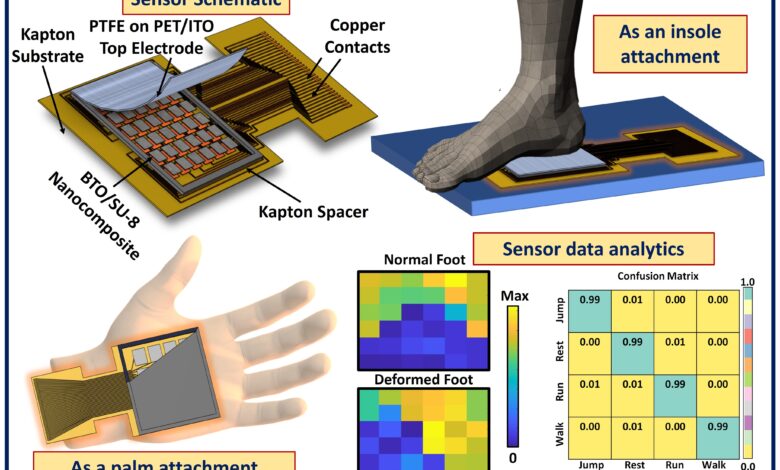IIT Delhi Researchers Unveil Innovative Wearable Pressure Sensor for Gait Analysis and Postural Deformities

New Delhi: In a significant stride towards addressing gait and postural deformities, which are prevalent and debilitating, researchers at the Indian Institute of Technology Delhi (IIT Delhi) have unveiled a scalable wearable pressure sensor that promises a cost-effective solution for analyzing gait patterns and identifying postural irregularities. These deformities, which encompass conditions like splay foot, flat foot, unstable hind foot, high arches, and irregular gait, are often associated with balance issues, abnormal posture, knee swelling, and joint weaknesses, leading to walking difficulties.
The new wearable pressure sensor has the potential to offer an easy and cost-effective alternative to pricier methods such as footwear modifications, surgeries, and posture correction accessories. This development comes as a boon for both medical professionals and patients, enabling efficient monitoring of gait and postural deformities, which can provide crucial insights into the recovery process or identify underlying medical conditions, thereby expediting patient recovery and preventing long-term harm.
The research team at IIT Delhi has engineered this wearable pressure sensor using a unique nanocomposite material. It incorporates a combination of light-sensitive polymer and piezoelectric nanoparticles, facilitating easy array design for pixelated sensing over a large area. The simple process flow and low-cost implementation make it suitable for human movement monitoring and injury rehabilitation.
The research study, titled ‘Machine Learning Assisted Hybrid Transduction Nanocomposite Based Flexible Pressure Sensor Matrix for Human Gait Analysis,’ authored by Nadeem Tariq Beigh, Faizan Tariq Beigh, and Prof. Dhiman Mallick from IIT Delhi’s Department of Electrical Engineering, has been published in the esteemed journal Nano Energy, known for its focus on nanotechnology (research paper link https://doi.org/10.1016/j.nanoen.2023.108824). The research project received financial support from the I-Hub Foundation for Cobotics, the Technology Innovation Hub of IIT Delhi.
The newly developed sensor, noted for its flexibility, can be easily implemented as a sensor array that fits comfortably within the insole of various shoe sizes. Moreover, it can be applied to any part of the body where localized pressure sensing is beneficial, such as the palm. The use of dual transduction nanocomposite materials enables the simultaneous sensing of mechanical strain and contact force/pressure, enhancing compatibility with existing Machine Learning algorithms by providing additional features.
Dr. Dhiman Mallick, the lead researcher and Assistant Professor at the Electrical Engineering Department of IIT Delhi, stated, “The integration of sensors and Machine Learning leads to the invention of intelligent sensors for cutting-edge technologies in fields like healthcare, sports science, defense, etc. During the number of tests that we conducted in our laboratory, we found that the proposed sensor can potentially help detect foot problems in adults and children by analyzing the pressure variation on the back end of the foot and converting it into electrical output. Since abnormal hind foot pressure distribution can lead to problems in knee joints, hips, and even spine-related injuries, understanding and correcting it is an important application.”
The sensor’s output is analyzed using conventional Machine Learning models, allowing clinical specialists to identify the type of deformity by comparing the pressure patterns to those of pre-defined patterns for a normal person. As a result, the pressure patterns can guide doctors and specialists in designing custom insoles to address foot deformities by supporting the regions with abnormal pressure distribution. This, in effect, presents a cost-effective alternative to expensive footwear modifications, surgeries, and posture correction accessories.
Furthermore, the sensor has the potential to identify various human activities, including walking, running, or other movements by detecting pressure changes in the hind foot. This capability has valuable applications in smart healthcare systems, particularly in analyzing critical health parameters for individuals with conditions like diabetes and obesity. The sensor is also useful for fall detection in the elderly, especially those with Parkinson’s disorder or disabilities.
The sensor’s versatility extends to injury rehabilitation, where it can assess hand grip strength. This feature is crucial in monitoring recovery, especially for limb injuries, where grip strength directly correlates with the healing process.
Dr. Mallick added, “This is just the beginning, but we have already demonstrated the usefulness of the proposed sensor in a number of applications, marking a significant step towards an intelligent healthcare evaluation environment.”
With its wide range of applications, the developed sensor opens up new possibilities for smart devices that can address various challenges in existing sensor technologies. Its potential spans across multiple sectors, including agriculture, healthcare, energy, industry, and sports, promising a significant technological impact.




